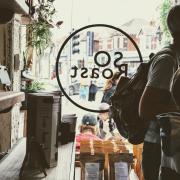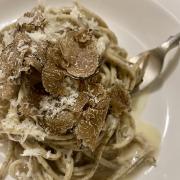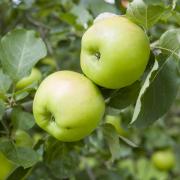Halfway along Silver Street in Sway, you’ll find Lightfoot’s Farm, home to Peter and Grace How and their two children. From vertical farming to forest gardening, they are working towards a sustainable food future. This month sees their first harvest of tree nuts
If anyone understands sustainable agriculture, it’s Peter How. With degrees in World Agriculture and Environment and Development, he spent many years working on projects to support smallholder farmers to develop resilient livelihoods. He worked as a senior researcher at The Organic Research Centre and has advised thousands of farmers in far-flung corners of Iraq, China, Kenya and Afghanistan – and now he’s the farmer. It was while working in Afghanistan that Peter met Grace who was in a development role looking after the health and welfare of the people in the remote Wakhan wilderness.

Grace and Peter moved back to the UK in 2014 and had two boys. When they bought the somewhat ramshackle Lightfoot’s Farm in 2018, they were looking to grow something sustainably with no pesticides in a small space. Not long after, their microgreens business was born. Peter explains: ‘Vertical growing indoors in a controlled environment means our crops aren’t affected by the increasingly unpredictable climate. Our customers can enjoy locally grown highly nutritious greens all year round and be confident about where they come from, how they are grown and who they were grown by.’
Marvellous microgreens

Microgreens are tiny versions of vegetables and herbs usually cut within 10-15 days of sowing, before the first true leaf emerges. This new growth is absolutely packed with bioavailable nutrients – they can be forty times more nutritious than the mature version. You eat them raw with no preparation and they can be sprinkled on anything, making them a very convenient and tasty way to reach your target of 30 plants a week.
Some of the best local restaurants use Lightfoot’s microgreens, including The Elderflower and The High Street Kitchen in Lymington, Verveine in Milford and Késarum in Southampton. Most of Lightfoot’s customers are households within 30 miles of SO41 who receive three or more mixed microgreen pots delivered to their doorsteps each week like a super-powered vegetable box scheme. They are also stocked in local farm shops and Peter sells at markets when he can.
New Forest nuts

This month sees the first nut harvest at the farm. Peter is enthused by his latest project to grow native tree nuts – predominantly cobnuts, but also walnuts and sweet chestnuts. While microgreens go a long way to meet our vitamin and mineral needs, growing tree nuts addresses another huge agricultural challenge to produce enough protein.
As well as the trees he’s planted on the farm, Peter is asking forward-thinking landowners for an acre or more of their land for him to farm. While these land owners will create attractive, carbon-fixing forest gardens and derive a future income, Peter will manage the trees and market the product creating a community forestry partnership that feeds people in a climate smart way. He wants to have nine acres of nut trees on at least three sites by 2027. Peter says. ‘We need to change our landscape to protect it and prepare ourselves for the more variable weather patterns we’re experiencing. This slows the onset of climate change, and also prepares us to produce more resiliently in a ‘changed’ climate. We need more trees, urgently, especially here in the New Forest where so much of the landscape is biologically impoverished.’

Peter is working with local businesses that share his belief in building sustainable food systems and restoring integrity in what we eat. This means creating a food system that is better for nutritional diversity, climate resilience and the local economy. One of these is Proudfoot & Co. (proudfootandco.com) in Winchester who will use Lightfoot’s nuts to make cobnut butter – a product with all the flavour and none of the airmiles. Peter is also working on product development with the chef/owner of plant-based eatery and deli The Tinker’s Granddaughter in Lymington (thetinkersgranddaughter.com).
If you’d like to be a part of this forward-thinking nut enterprise, you can ‘adopt a nut tree’ for £40; Peter will plant, protect and care for a tree on the farm and send you 500g of UK-grown nuts during the next harvest. Alternatively, connect with Peter if you have land, are interested in a corporate day of tree planting or would like to play some other role in the enterprise.

Living on the land
Peter and Grace have created a wonderful place for guests to stay at the farm between April 1 and October 31 each year. They have five furnished bell tents on four pitches in a wild hay meadow. Each pitch has its own private wood-fired hot tub, eco toilet, shower, fire pit and picnic table. There is also a shared field kitchen with a fridge, freezer, hob and dining table. It’s a wonderful spot for exploring the beaches and the forest, or just to stay put and slow down. Some local companies use Lightfoot’s Farm for their corporate away days – as Peter and Grace know, the value of being immersed in nature is immeasurable.
Find out more at lightfootsfarm.com
Walnut and Yuzu Macarons Chef and patron of award-winning fish restaurant Verveine, David Wykes takes inspiration from the Solent’s coastline and The New Forest. He has been using microgreens from Lightfoot’s Farm for three years, and says: ‘The taste, freshness and variety make them the best microgreens I’ve ever used.’ His recipe here was inspired by walnuts grown at Lightfoot’s Farm.
Ingredients (Makes 30)
310g icing sugar
310g ground almonds
230g egg whites
A few drops of food colouring
300g caster sugar
75g spring water
For the filling
150g 70% dark chocolate
37g double cream
100g yuzu juice
4g good quality walnut oil
Chopped walnuts
Method
1. Sift the icing sugar and the ground almonds together. Add 115g of egg whites and beat by hand to a fine smooth paste. Add your chosen colouring, then set aside.
2. Put the remaining 115g egg whites in the mixer bowl.
3. In a separate pan, mix the caster sugar and water. When it reaches 117°C, pour onto the egg whites in the mixer bowl and whip until cold.
4. Beat one third of the meringue into the almond paste and then gently fold in the rest.
5. Pipe into rounds on a non-stick mat and leave to form a skin at room temperature for one hour.
6. Bake at 180°C until the macaron has a firm base and doesn’t move when touched (approx. 12 minutes), then remove from the oven and cool.
7. Make the filling by bringing the yuzu juice, walnut oil and cream to a boil.
8. Pour the mixture onto the dark chocolate, whisking until smooth.
9. Cover the surface with cling film to stop a skin from forming and leave it to reach room temperature.
10. When it is set, pipe a small quantity of the filling onto one macaron shell with a small piece of walnut in the centre, then sandwich with another macaron shell.



























